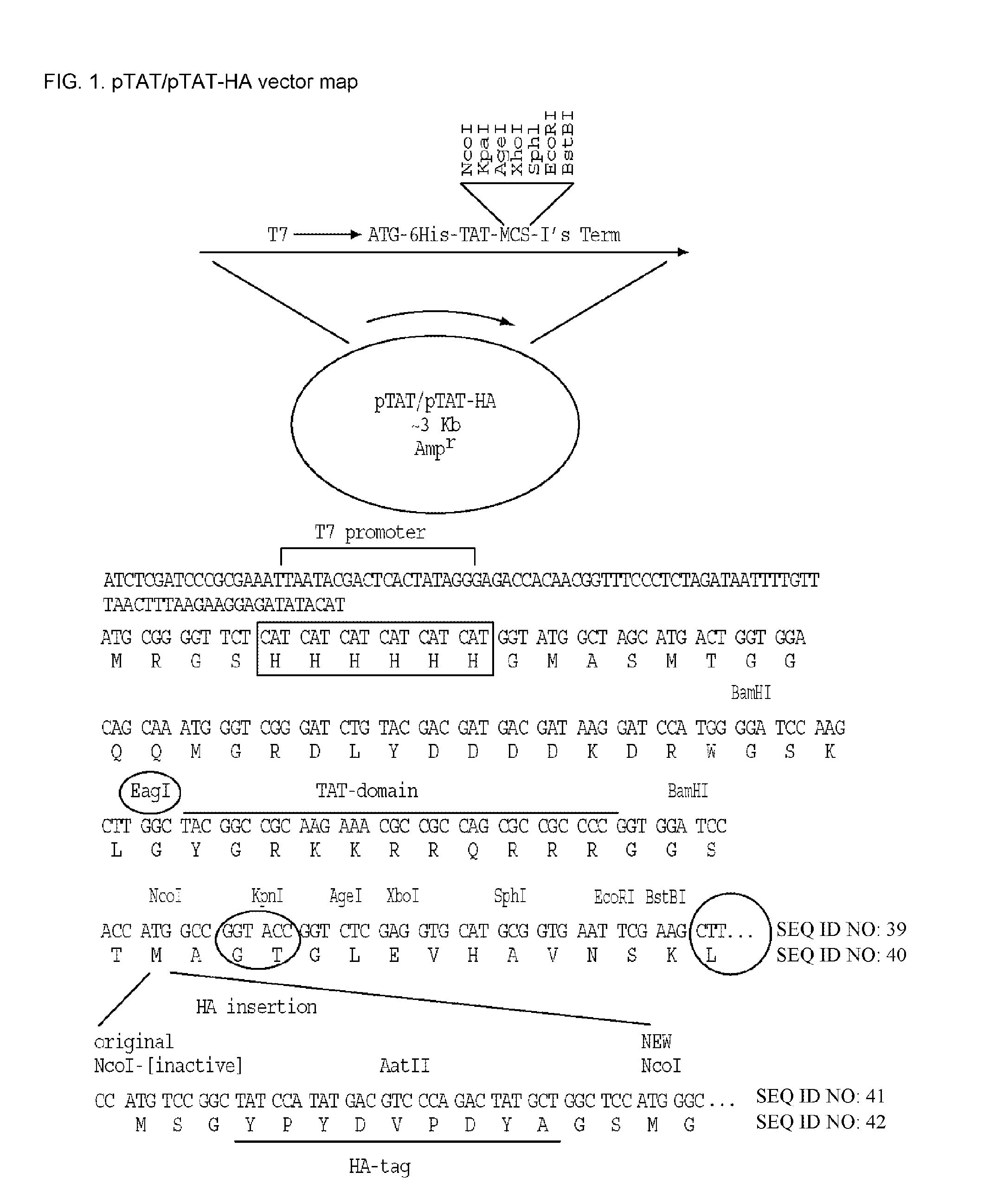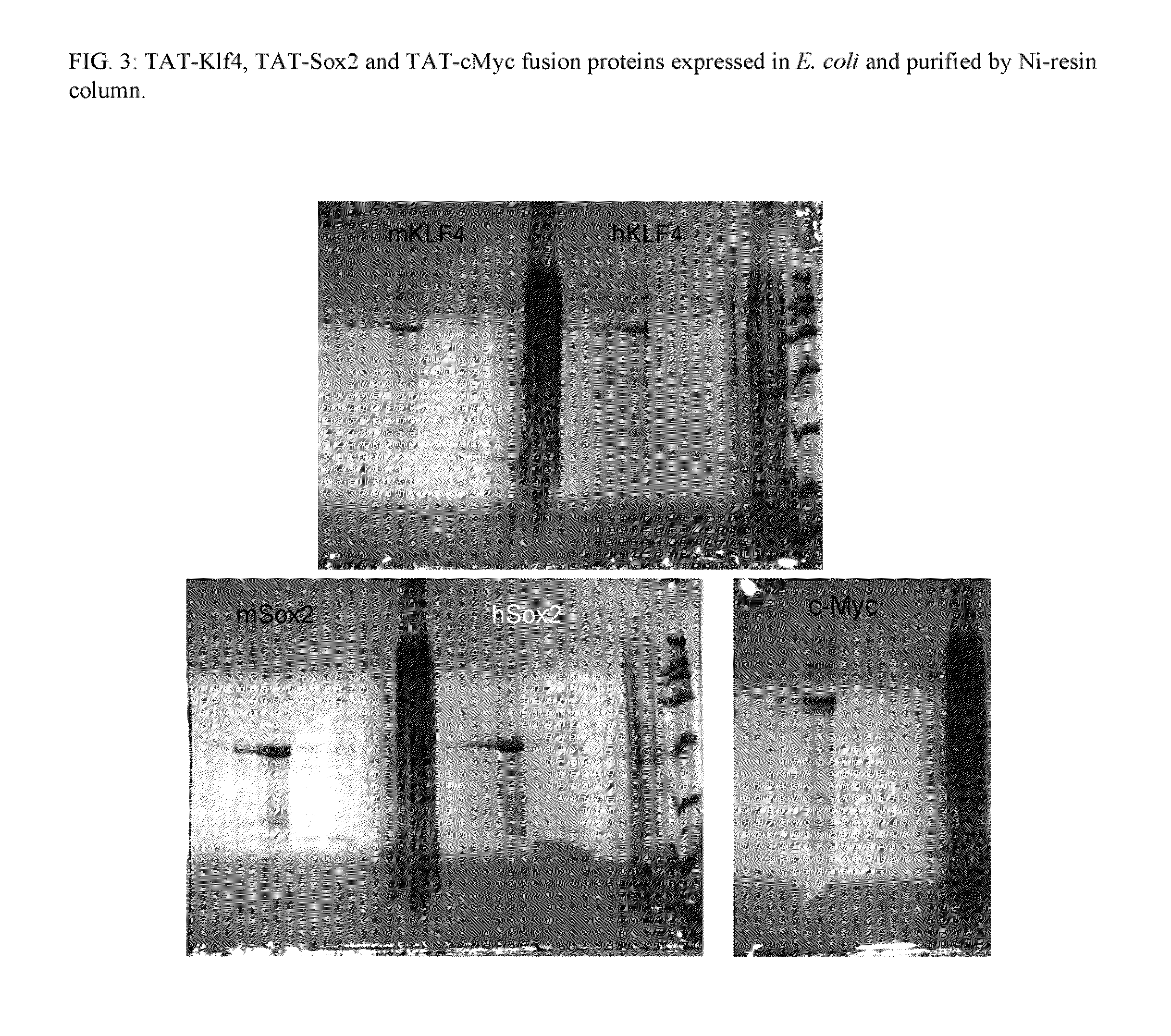Genetically Intact Induced Pluripotent Cells Or Transdifferentiated Cells And Methods For The Production Thereof
a technology of induced pluripotent cells and transdifferentiated cells, which is applied in the direction of biocide, peptides, drug compositions, etc., can solve the problems of es cell research being impeded, slowed advancement in this field, and not being suited to normal or histocompatible cells for transplantation, so as to improve the degree of reprogramming of somatic cell genome, prolong the length of telomeres and thus replicative lifespan, and facilitate the degree of reprogramming
- Summary
- Abstract
- Description
- Claims
- Application Information
AI Technical Summary
Benefits of technology
Problems solved by technology
Method used
Image
Examples
example 1
Fusion protein constructs
[0484]Expression vectors encoding reprogramming polypeptide were generated. The reprogramming polypeptides generated were human and mouse Oct4, Nanog, Klf-4, c-Myc, and Sox-2. Accession numbers for each gene are shown in Tables 1 and 2. To facilitate purification, detection, and introduction into recipient cells, the expression constructs included in-frame fusion to a protein transduction domain (PTD), an HA tag, and a 6×His tag. Human and mouse clones encoding the open reading frames were obtained from ATCC. The pTAT-HA-hOct4 and pTAT-HA-mOct4 expression vectors were generated by cloning PCR fragments encompassing the human and mouse Oct4 gene open reading frames into the NcoI and EcoRI sites of the pTAT-HA expression vector (FIG. 1). Vectors encoding Nanog, Klf-4, c-Myc, Sox-2, and Lin28 fusion proteins were cloned by essentially the same methods, with PCR products inserted into the pTAT-HA vector, resulting in the following constructs (with insertion site...
example 2
Purification of Recombinant Proteins Expressed in Bacterial Cells
[0485]The plasmids pTAT-HA-hOct4 and pTAT-HA-mOct4, pTAT-HA-hNanog, or pTAT-HA-mNanog were each transformed into E. coli strain BL21(DE3)pLysS (Invitrogen), which contains an IPTG-inducible gene for T7 RNA polymerase. Fusion protein expression was induced by the addition of 1 mM IPTG at 30° C. for 4 h. The 6×His-fused recombinant proteins were observed to be sequestered into inclusion bodies by the host bacteria. To obtain purified protein, cells were disrupted by sonication in denaturation solution (6 M guanidinium, 20 mM NaPO4, and 0.5 M NaCl, pH 7.8) and the 6×His-fused recombinant proteins were then bound to nickel resins (ProBond resin, Invitrogen). After several washings, the fusion proteins were eluted in 20 mM NaPO4, pH 4.0, 0.5 M NaCl, 8 M urea plus 100 mM imidazole. The purity and concentration of the fusion proteins were determined by SDS-PAGE gel electrophoresis and visualized with Coomassie blue staining (...
example 3
Treatment of ES Cells with TAT-Oct-4
[0487]To test the hypothesis that addition of reprogramming proteins could help maintain stem cell lines in an undifferentiated state, the effect of TAT-Oct-4 on human ES cells was then tested. ES cells were grown under standard conditions, and the purified TAT-Oct-4 generated in Example 2 was added to the culture medium (the TAT-Nanog protein was not tested due to its poor solubility). The ES cells were then returned to a CO2 incubator and visually monitored. The ES cell colonies expanded and showed morphological signs of differentiation. Differentiation was confirmed by Alkaline Phosphatase (AP) staining. The TAT-Oct-4 treated cells showed diminished AP staining intensity relative to control human ES cell colonies (FIG. 4).
[0488]These results indicate that addition of TAT-OCT-4 alone may be insufficient to maintain ES cells in an undifferentiated state and suggests that a combination of reprogramming proteins would be more efficacious.
PUM
| Property | Measurement | Unit |
|---|---|---|
| diameter | aaaaa | aaaaa |
| size | aaaaa | aaaaa |
| concentration | aaaaa | aaaaa |
Abstract
Description
Claims
Application Information
 Login to View More
Login to View More - R&D
- Intellectual Property
- Life Sciences
- Materials
- Tech Scout
- Unparalleled Data Quality
- Higher Quality Content
- 60% Fewer Hallucinations
Browse by: Latest US Patents, China's latest patents, Technical Efficacy Thesaurus, Application Domain, Technology Topic, Popular Technical Reports.
© 2025 PatSnap. All rights reserved.Legal|Privacy policy|Modern Slavery Act Transparency Statement|Sitemap|About US| Contact US: help@patsnap.com



